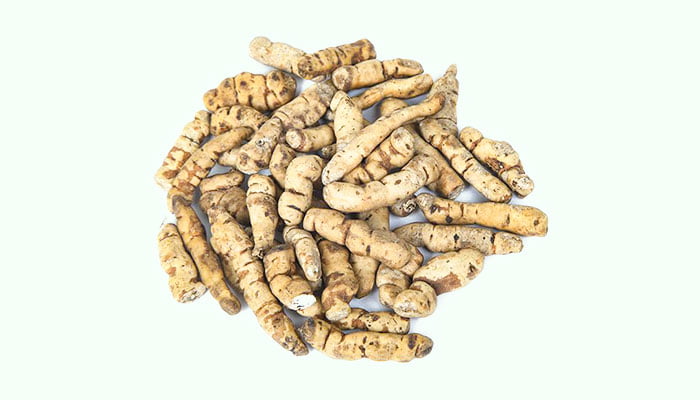What Is Gan Sui
Gan Sui also known as Radix Kansui or Kansui Root is the tuberous root of Euphorbia kansui, which is a perennial herb belonging to the family Euphorbiaceae. It is a well-known traditional Chinese medicine, which first appeared in <Shennong Ben Cao Jing> in the late Western Han Dynasty (around 100 BCE).
This plant often grows on low mountain slopes, barren slopes, sandy land, fields, or roadsides. It is endemic to China and is distributed in Gansu, Shanxi, Shaanxi, Ningxia, Henan, and Qinghai. It has now been cultivated artificially.
In the early spring and late autumn of each year, people gather the tuberous root of Euphorbia kansui, remove their outer skin and impurities, dry them, use them directly, or stir-fry them with vinegar, and make them into Chinese herbal medicines.

Gan Sui contains ingenol-3-(2, 4-decadienoate)-20-acetate, kansuiphorin C, kansuinin A, kansuinin B, kansuinin C, kansuinin D, kansuinin E, kansuinin J, euphol, tirucallol, kansenonol, kansenone, epikansenone, 11-oxo-kansenonol, kansenol, kansuinone, β-sitosterol, stigmast-5-ene-3β, 7β-diol, isoscopletin, palmitic acid, oxalic acid, tannins, resins, glucose, sucrose, starch, and vitamin B1.
According to <Shennong Ben Cao Jing>, the medicinal nature of Gan Sui is relatively cold, with toxicity and a bitter taste. It has a certain therapeutic effect on the pathological changes of the lung, kidney, and large intestine meridians.
In traditional Chinese medicine, Gan Sui is often used to remove water retention, alleviate swelling and dissipate indurated mass, treat difficulty in urination and defecation, skin ulcers and abscesses, acute pancreatitis, asthma, ascites, pertussis, intestinal obstruction, chronic bronchitis, epilepsy, tuberculous exudative pleurisy, hydrocele in children, rheumatoid arthritis, erythema multiforme, esophageal cancer, lung cancer, and cancerous melanoma.
There are about 30 kinds of Chinese medicine prescriptions containing Gan Sui, such as Gansui Banxia Tang, Shi Zao Tang, and Da Huang Gan Sui Tang.
Benefits
- Inhibiting influenza virus, chicken Newcastle disease virus, human immunodeficiency virus.
- Killing Culex pipiens larvae, Aedes albopictus larvae, nematodes, and Japanese termites.
- Inhibiting the activity of topoisomerase II and cell division.
- Anti-oxidation, enhancing the activity of superoxide dismutase and glutathione peroxidase and inhibiting lipid peroxidation.
- Stimulating the intestines, promoting bowel movements, and inducing diarrhea.
- Promoting the excretion of retained water, treating tympanites, pleural effusion, ascites, and systemic edema.
- Alleviating constipation and dysuria and treating lower abdominal bloating in women.
- Eliminating phlegm and treating epilepsy caused by wind-phlegm.
- Alleviating swelling and dissipating nodulation, treating skin sores and abscesses.
- Inhibiting the growth of HepG2 cells, human epithelioid liver cancer BEL-7402 cells, and MCF-7 breast cancer cells.
- Its crude extract can inhibit delayed allergic reactions induced by sheep red blood cells. The research shows that it has a suppressive effect on the immune system.
- Studies have confirmed that intraperitoneal or intramuscular injection of its ethanol extract into pregnant guinea pigs can induce labor.
Combinations
- It can be used in combination with Da Huang (Radix et Rhizoma Rhei) and Mang Xiao (Natrii Sulfas), etc. to treat tuberculous exudative pleurisy.
- It can be used in combination with Da Huang (Radix et Rhizoma Rhei), E Jiao (Colla Corii Asini), etc. to alleviate dysuria and lower abdominal bloating in women.
- It can be used in combination with Chan Su (Venenum Bufonis), Sha Ren (Fructus Amomi), Mu Xiang (Radix Aucklandiae), Ji Nei Jin (Endothelium Corneum Gigeriae Galli), Shan Zha (Hawthorn Fruit), etc. to treat ascites caused by liver cirrhosis.
- It can be used in combination with Jing Da Ji (Radix Euphorbiae Pekinensis), Yuan Hua (Genkwa Flos), Da Zao (Fructus Jujubae), etc. to treat pleural effusion, ascites, and systemic edema caused by exudative meningitis, tuberculous pleurisy, liver cirrhosis, or chronic nephritis.
- It can be used in combination with Ban Xia (Pinellia Rhizome), Bai Shao (White Peony Root), Zhi Gan Cao (Radix Glycyrrhizae Preparata), etc. to treat pleurisy, chronic diarrhea, and pericardial effusion.
Side Effects
- Gan Sui is poisonous, and its incidence of clinical toxicity reactions is relatively high.
- Continuous intravenous administration for one week can cause toxic damage to the heart, liver, and kidney.
- It has a strong stimulating effect on the skin and mucous membranes. Taking it may cause inflammation such as mucosal hyperemia, edema, and even erosion.
- Excessive use of it may cause abdominal pain, diarrhea, watery stool, tenesmus, vomiting, dizziness, or headache.
- In severe cases, it can cause rice soup-like stool, palpitations, drop in blood pressure, dehydration, difficulty breathing, weak pulse, drop in body temperature, delirium, cyanosis, respiratory failure, or death.
Precautions and Warnings
- The dosage of Gan Sui should be controlled at 0.5-1g.
- It can be made into decoctions, pills, powders, or ground for external use.
- Stir-frying it with vinegar can weaken its toxicity and cathartic effect.
- People who are allergic to Gan Sui should not take it.
- It should not be used with Gan Cao (Licorice Root), Yuan Zhi (Radix Polygalae), or spironolactone.
- Weak people should not take it.
- Pregnant women and breastfeeding women should not take it.
